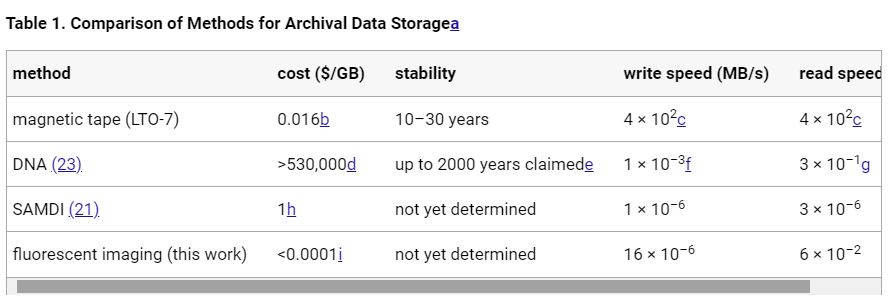Harvard’s New Dye-Based Storage Could Preserve Data for Thousands of Years
It efficiently stores data in liquid dye and is translated from binary by researchers.
According to an ACS Central Science report, Harvard’s George Whitesides lab chemists have developed a new method of storage that it says involves using seven common mixtures of fluorescent dyes to save data in a faster, more efficient way than other exotic molecular information-based data archival technologies.
ACS Central Science describes the approach, which involves dropping the dyes through an inkjet printer and reading the varying wavelengths of light it emits through a microscope. The binary message is then decoded from the molecules “back to documents, books, photos, videos, or anything else that can be digitally stored,” according to a news post from Harvard University.
Researchers predict that data could stay intact for thousands of years using the method, as opposed to contemporary storage devices like Blu-rays and computer drives, that have an average lifespan of 40 years at most. Once data is recorded, the dye method uses no energy in order to maintain itself, unlike most forms of bulk data storage that use costly physical servers to keep data available. The lab also says the process adverts issues like water damage and hacking, making it an ideal method of storing sensitive data, such as financial or legal records.

The dye method is also relatively cheaper to produce and has speedier read/write capabilities than any molecular information method to store data that the Whitesides lab has studied throughout the years. Previous methods include using artificial DNA and altered molecules to store data but that has been deemed too costly and slow to yield anything groundbreaking. The dye system however writes at an average of 128 bits per second and reads at a rate of 469, which is the fastest rate achieved by any molecular method to date. While this is faster than those competing methods, it still pales in comparison to today's SSDs and HDDs, meaning that this is firmly intended for long-term archival storage only.
Researchers use the American Standard Code for Information Interchange to carefully decode data from the dye molecules. A specific microscope is also used to read the dye molecules that have chemically bonded to an epoxy surface. By determining the ones and zeros found in the dye molecules and deducing which dye remains, its binary message can be decoded.
Harvard has licensed the technology to a new digital data storage company co-founded by Nagarkar, Whitesides, the Woodford L., Ann A. Flowers University Professor, and former postdocs Michael Fink and Alexei Ten, to develop the method into a commercial product. The aim is to partner the tech with existing data storage providers, as Nagarkar believes “in the future, we will need to store large amounts of data as our society transitions to a digital society.”
Get Tom's Hardware's best news and in-depth reviews, straight to your inbox.

Isaac Rouse is a staff writer at Tom's Hardware. He reviews laptops and various gaming peripherals.
-
Endymio ReplyOnce data is recorded, the dye method uses no energy in order to maintain itself, unlike most forms of bulk data storage that use costly physical servers to keep data available....
Err, what? Magnetic tapes and hard drives only require "costly physical servers" to retrieve the data, not to maintain the storage ... exactly the same as this dye storage method. -
Raul_McCai Reply
Journalists in all areas are increasingly prone to flights of fancy.Endymio said:Err, what? Magnetic tapes and hard drives only require "costly physical servers" to retrieve the data, not to maintain the storage ... exactly the same as this dye storage method.